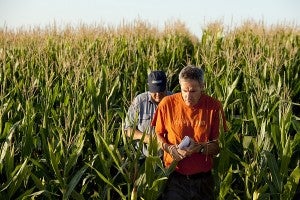Corn is our country’s biggest crop economically and takes up nearly one-third of U.S. cropland. It is a pillar of our food production system – a key ingredient in everything from drinks, sauces and snack foods to dairy products, fuel and meat.
So when news about corn’s risky future pops up, we should all take note, and the entire agricultural supply chain should work toward solutions.
Water & Climate Risks Facing U.S. Corn Production, produced by the nonprofit sustainability advocate Ceres, is the latest analysis to sound the warning bell.
Last year U.S. corn growers harvested a record 14 billion bushels of corn, making them among the most productive farmers in the world (this year’s harvest is expected to be huge as well). But climate change and groundwater depletion are threatening to undermine corn’s success as global demand increases. Inefficient fertilizer use is compounding the problem.
According to the Ceres report:
- 87 percent of irrigated U.S. corn is grown in regions with high water stress, meaning there is limited additional water available for irrigation expansion.
- 27 percent of rain-fed corn is grown in regions with high water stress, which limits water availability should climate change make irrigation necessary.
- Midwestern agricultural communities faced a 45-percent increase in extreme precipitation events between 1958 and 2011, elevating the risks of dangerous floods.
- Severe weather has already contributed to a steady uptick and unprecedented volatility in corn prices – from $2 a bushel a decade ago to a record $8 a bushel during the devastating 2012 drought.
“This volatility has vast implications for the many industries that rely on corn,” the report says. “High corn prices in the wake of extreme flooding in spring 2011 and the prolonged drought in 2012 shuttered ethanol plants, contributed to the culling of beef herds, and reduced margins for many processed food and beverage companies.”
Cities are also feeling the impacts of corn production, which uses the most fertilizer of all major U.S. crops. Fertilizer run-off from crops pollutes water and causes dead zones downstream. The USDA estimates that large water utilities spend more than $4.8 billion per year on removing nitrate from U.S. drinking water supplies.
What Can Be Done
The Ceres report might paint a bleak picture. But I’m optimistic.
Farmers across the U.S. have made significant conservation improvements over the past few decades. EDF has worked with farmer networks in 12 states to improve efficiency and reduce fertilizer loss on more than a half million acres, and that work is rapidly expanding.
Meanwhile, retail giants like Walmart are getting into the act. Last fall, the company launched a GHG-reduction initiative that requires vendors using commodity grains in their products to submit fertilizer efficiency plans. Fertilizer not absorbed by crops emits a power greenhouse gas – which Walmart identified as the top GHG hotspot in nearly half of its top 100 products.
To date, 15 major suppliers – representing 30 percent of food and beverage sales in North America – have developed fertilizer optimization plans. Among those vendors are General Mills, Coca-Cola and Smithfield, the world’s largest pork producer.
More work needs to be done to engage the entire supply chain, but the momentum is growing.
In the past few months, I’ve met with grain buyers and agribusinesses that see the financial value in helping corn and grain farmers become more sustainable. And Field to Market, a multi-stakeholder supply chain alliance, recently launched a program – which EDF helped to develop – for measuring, promoting and reporting on sustainability improvements in commodity crops.
Corn touches us all, which means we have no time to waste in reducing its risks. And I do mean “we.”
Consumers, retailers and food companies need to increase demand for sustainable grain products, while farmers and agribusiness need to increase supply.
We need a system that provides economic benefits to farmers who improve input efficiency, soil health and yields while simultaneously increasing their own resilience to extreme weather. And we need mainstream agriculture to become and be recognized as a major contributor to the elimination of aquatic dead zones, improved drinking water quality and reduced greenhouse gas emissions.
We all have a role to play, so let’s go get the job done!










